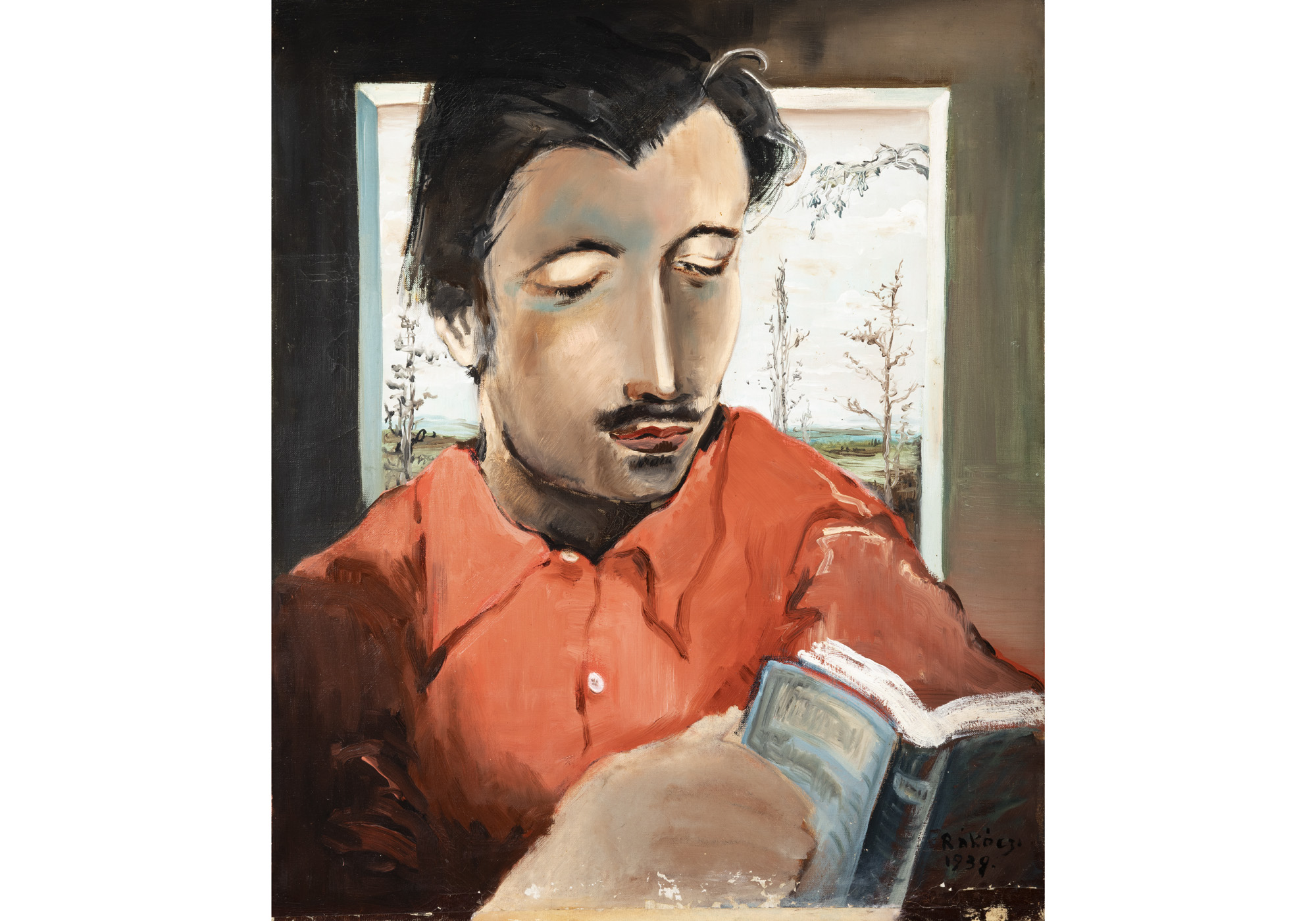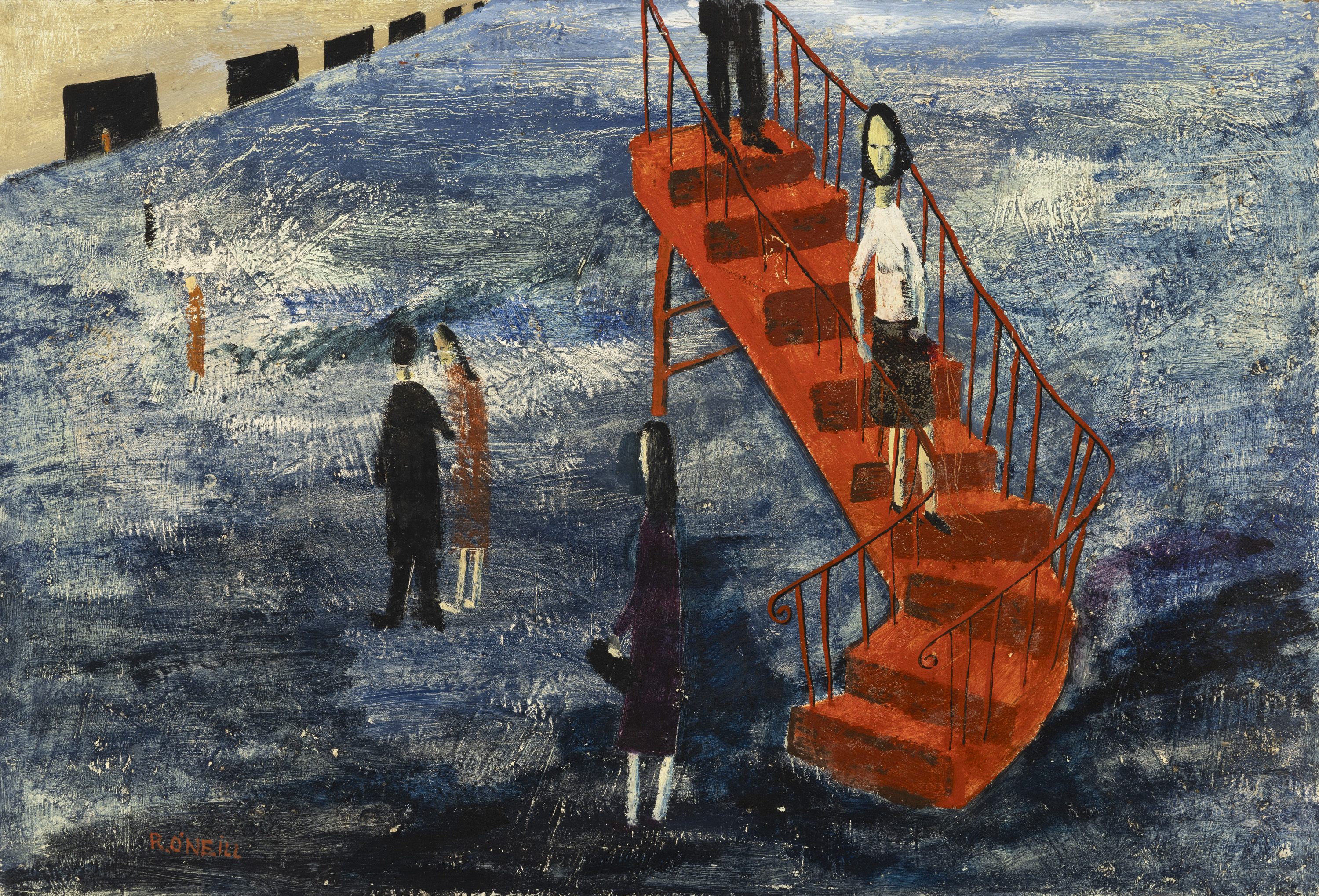Departments
.svg)


Charles Lamb was a talented painter whose output encompassed portraits, still-life, Breton subjects, western and northern landscapes, harbour and fishing scenes, as well as depictions of the Famine, and the Claddagh. Fisherman with Lobster is a leading work of Lamb’s mid-career purchased in the 1940s from the artist by Jack McCabe of Portadown. McCabe knew and admired Lamb, and according to his son John, he purchased one of his paintings with his first pay packet (correspondence, 1998). McCabe continued buying works by Lamb when he was a young artist, and they formed the nucleus of the collection, which hung in his wife’s hotel, the Seagoe Hotel, Portadown, in the restaurant that became known as ‘Lambs’. The Lamb Restaurant opened in the early 1980s attended by many of the Lamb family. It was a popular venue and, in its heyday, displayed eleven works by Lamb ranging from northern landscapes painted in Rostrevor and around the River Bann to scenes from the west of Ireland, the largest of which was Fisherman with Lobster (correspondence with Jack McCabe’s wife, 1994). The painting dates to c.1937, when Lamb showed a work listed as The Lobster Man at Newry Feis, which is likely to be Fisherman with Lobster.
The portrait is of Pádraic Ghrealís from Rinn, Connemara, known as ‘the lobster man’. He was married to Nan Mhichil Liam Mc Donagh, a close friend of the Lamb household, her portrait is in the National Gallery of Ireland. Ghrealís was a great sailor and deep-sea fisherman, as the portrait shows, earning his livelihood from lobster fishing. The couple had several daughters and four sons who, together with their father, were great rowers. The composition emphasises the large, seated figure, possibly positioned above Caladh Thaidhg harbour, overlooking in the background the small island and village of Lettermullan across from Carraroe. Ghrealís and his wife Nan modelled for other works by Lamb including, a commission from the Haverty Trust in 1934, to paint Pattern Day in Connemara, for University College Galway. The subject is the ancient ritual of the pattern, where a traditional pilgrimage to a site associated with a local saint involved people doing circuits around a holy well with prayers and penance.
At the time that Lamb painted Fisherman with Lobster he was living in Carraroe, Co Galway. Born in Portadown, he trained at the Belfast School of Art, winning a scholarship to the Dublin Metropolitan School of Art (NCAD), where he graduated in 1921. Pádraic Ó Conaire, the Galway poet and writer, encouraged him to go to Connemara to find the landscape and skies he wanted to paint. In 1923 he met Katharine, the daughter of Ford Madox Ford, who was studying veterinary medicine in Dublin, and in 1927, after Lamb’s trip to Brittany, the couple were married. They settled in Carraroe, where in 1933, Lamb built a house and studio to accommodate their growing family. In the 1930s he was elected an academician of the Royal Hibernian Academy (RHA) and the Ulster Academy of Arts (RUA).
Lamb began painting single figures early in his career. An early example, The Lough Neagh Fisherman, 1921 (Ulster Museum), portrays a young northern fisherman against the backdrop of Lough Neagh. It is a confident study that demonstrated Lamb’s skill at portraiture and helped him to make his mark at the RHA. He developed this portrait style into an idealised form of ‘national type’, which by 1930, included figures from the west of Ireland, singly or in couples, most notably in the well-known iconic painting, The Quaint Couple, 1931 (Crawford Art Gallery, Cork). In Fisherman with Lobster, Lamb employs a golden light on the right of the figure leaving the left in shadow, placing Ghrealís in the foreground to stand out against a brilliant background landscape and blue sky. His hands hold a lobster and pot, and his rugged weather-beaten face betrays a lifetime of fishing. Ghrealís wears a well-used báinín jacket, brown striped geansaí, and black cap. The portrait is a work of great assurance and confident painting, reflecting virtuosity of brushwork in the tonal build-up of the face, the vivid blue sea and green island landscape. This is Lamb at his best illustrating a form of monumental portraiture at which he excelled, depicting the people he felt reflected the ‘national essence’ and, in the process, becoming one of Ireland’s most influential 20th century landscape painters.
During Lamb’s subsequent career, he ran a summer school from 1936 to 1950s in Carraroe, attended by numerous important artists, and hosted a summer exhibition where visitors could see and buy his paintings. He illustrated ‘Cré na Cille’ by Máirtín Ó Cadhain (1949) and ‘An Tincéra Buí’ by Séan Ó Coisdealbha (1962). His work was shown internationally in London, Brussels, New York, Boston, and Ottawa, the 1933 Century of Progress Exhibition Chicago, the 1923 Olympic Games Exhibitions in Los Angeles, and 1948 in London. He exhibited at the RA, RUA, RHA, Oireachtas, Aonach Tailteann, Dublin Painters Gallery, and at art societies in Belfast, Cork, Galway, Limerick, Tipperary, and Waterford. Lamb died in 1964 and is buried in Carraroe.
Dr. Marie Bourke, August 2022



Through this article, let our expert Adam Pearson guiding you to the (re)discovery of the once established Irish painter Richard O’Neill.












Buying at Auction and the Role of Antiques in a Modern Home




Important Irish Art Auction Highlights

Oliver Dowling Collection by Aidan Dunne




2024 is a year in which Adam’s wants to recognise the key role buying antique furniture and furnishings at auction contributes greatly to the sustainable initiative. In 2019 the Environmental Protection Agency reported stark figures that each year in Ireland 1.2 million reusable bulky items, primarily furniture goes into landfill. Similar to the problem of ‘fast fashion’, the constant production and consumption of new items is leading to rapidly growing waste problem. We want to acknowledge those who are already buying second hand or antique furniture at auction and to encourage new buyers by highlighting the benefits of acquiring affordable, well-made quality items that are built to last.







Irish author, recipe creator and lifestyle influencer, Indy Parsons, selects her favourite pieces from our upcoming Fine Jewellery & Watches auction










.jpg)

Cork-born Irish actress, Sarah Greene, selects her favourite pieces from our upcoming Fine Jewellery & Watches auction




Yvonne Aupicq had met Orpen, we understand, while working as a nurse during the war. He had been admitted to hospital with a suspected case of scabies which ended up being a far more serious case of blood poisoning as he recounts in his wartime memoir ‘An Onlooker in France’. Their relationship continued after 1918 when Orpen was appointed as the official artist to The Paris Peace Conference. They relocated to capital and over the following decade he painted her numerous times, often nude as in Amiens 1914, or The Rape and Nude Girl Reading (1921). Working with her as his model during these early years after the war allowed Orpen an opportunity to re-fuel his creativity.





Editor-in-Chief of IMAGE Publications, Lizzie Gore-Grimes, selects her favourite pieces from our upcoming Fine Jewellery & Watches auction

Our upcoming Fine Jewellery & Watches auction on September 13th features a prime example of Van Cleef & Arpel's renowned 'Mystery Setting'


Our June auction offers a once-in-a-lifetime opportunity to acquire one of the great masterpieces of Irish art and icons of Dublin’s history.



Georgia Chiesa selects some of her favourite lots in the upcoming Vintage Wine & Spirits Auction


"Beating the bounds is a tradition that can be traced back to the medieval period. At this time, land was divided into parishes and the clergy and church wardens held the responsibility for its upkeep and management. It was up to the Church to ensure that its parishioners knew the local boundary lines and, before maps became commonplace, this had to be kept as a mental record."

Adam’s in conjunction with Suzanne MacDougald are proud to host an online timed auction of artworks to aid the Irish Red Cross’s humanitarian work in delivering vital services to millions of people impacted by the conflict in Ukraine. With no buyers premium 100% of the hammer price will go directly to the Irish Red Cross.

Ros Drinkwater writes of Jack B Yeats' 'The Boat' in the Business Post:


With a consolidated result of €320,000,the At Home sale in Stephan’s Green, was a great success.

